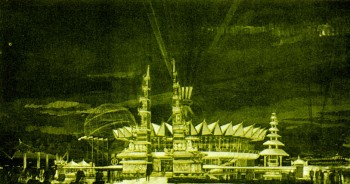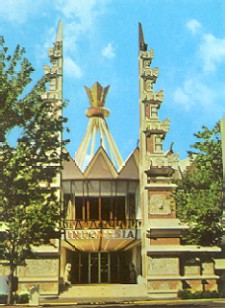|
The first Asian country to sign up for
the Fair was Indonesia, responding only four days after receiving
the invitation. According to the Announcement of the Information
Minister, "The participation of Indonesia…is in the
course of the realization of the ideals of the Indonesian Revolution
in the international field with the purpose for concluding good
friendships between the Republic of Indonesia and all world nations…."77 President Sukarno requested that his pavilion
be "dramatically placed" between those of the United
States and the Soviet Union, to represent Indonesia's neutrality
in the Cold War.78
For six months, Indonesia rejected site offers for their failure
to be equidistant enough to suit his neutral sentiments.79 Finally Sukarno, who came to the US to meet
with President Kennedy on behalf of the Belgrade conference of
non-aligned nations, visited the Fairgrounds to select the location
of the pavilion. Sukarno chose a 40,000 square foot plot, and
Indonesia became the first nation to formally conclude leasing
arrangements with the Fair.80
Architectural rendering of the Pavilion of
Indonesia*
 |
Indonesia's Pavilion had a political focus,
reflecting a "desire for creating a synthesis between Western
and Eastern ideologies." It sought to give one an "impression
of what Indonesia regards as its active and independent foreign
policy."81 Sukarno
hand-selected the female guides for the Indonesian Pavilion,
advising them not to "wiggle" like French or American
girls, but to "be Indonesian girls in every one of [their]
actions."82 For Sukarno,
the Indonesia Pavilion's purpose was to function as an expression
of post-colonial independence of nation, ideology and spirit.
Besides choosing the Indonesian girls for
the Pavilion, Sukarno devoted considerable time to planning the
Pavilion itself. He was a painter, an art enthusiast and a jewel
collector, and he put together displays of his personal items
for the Fair. Sukarno was also an engineer, and actually helped
plan the design of the building. His aides recalled that many
times they would approach him with a matter of importance "and
find him so intent on his blueprints for the Fair pavilion that
they could scarcely get his attention."83 Unfortunately, Sukarno would never see the
final product in person.
Outside of the Fair, the cordiality of
relations between the United States and Indonesia began to deteriorate.
The [Fair's International Affairs and Exhibits division] designated
May 16, 1964 as "Indonesia Day." Sukarno had been invited
to attend the festivities, but Washington advised him that American
sentiments towards him were hostile after Indonesia had made
attacks on American foreign policy. Sukarno announced he would
not be attending the Fair, giving as his reason the "Current
Malaysia-Indonesia Dispute." He sent a deputy in his place.84
Although Indonesia withdrew from the United
Nations in January of 1965, Sukarno indicated that Indonesia
would continue to exhibit at the Fair for the second season.
By February of that year, however, the prospect was looking slim.
Several offenses to the United States in Indonesia, including
attacks on US Information Agency libraries, the boycotting of
American ships, and a slew of "anti-American Communist outrages"
prompted the Johnson Administration to threaten action against
Indonesia. One penalty Johnson considered was shutting down Indonesia's
Fair pavilion, to demonstrate "that the US won't be pushed
around."85
On March 11, Sukarno made an official announcement
of withdrawal from the Fair for the 1965 season. His action was
a protest against American support of the "neo-colonialist
project of Malaysia." The United States had given a $4 million
credit to Malaysia for weapons, an action that, Sukarno said,
mocked the theme of the Fair.86
The Fair seized the Pavilion and barred any Indonesian officials
from entering the Fairgrounds. The manager of the Indonesian
exhibit, S. Haditirto, was disturbed by the sudden cold shoulder
from the Fair Corporation. "I do not understand," he
said. "It seems that an iron curtain has suddenly descended
between us and the Fair Corporation."87 For the entire second season of the Fair,
the Indonesia Pavilion stood barricaded and vacant.
This photograph of the Indonesia Pavilion appeared
in the 1965 Official Souvenir Book
of the Fair. However, the pavilion remained closed; the entrance
guarded and padlocked during the 1965 Season.*
 |
Exactly one year after Sukarno pulled his
country out of the Fair, he lost his presidency to a US-backed
anti-Communist military general. Sukarno spent the rest of his
life in house arrest. Indonesia, the first country to join the
Fair, descended into a thirty-year period marked by censorship,
genocide and corruption under the new President Suharto.88 The neutrality that had been so important
in the initial negotiations between Indonesia and the Fair was
all but lost.
© Copyright 2005 Sharyn Elise Jackson, All Rights
Reserved.
|